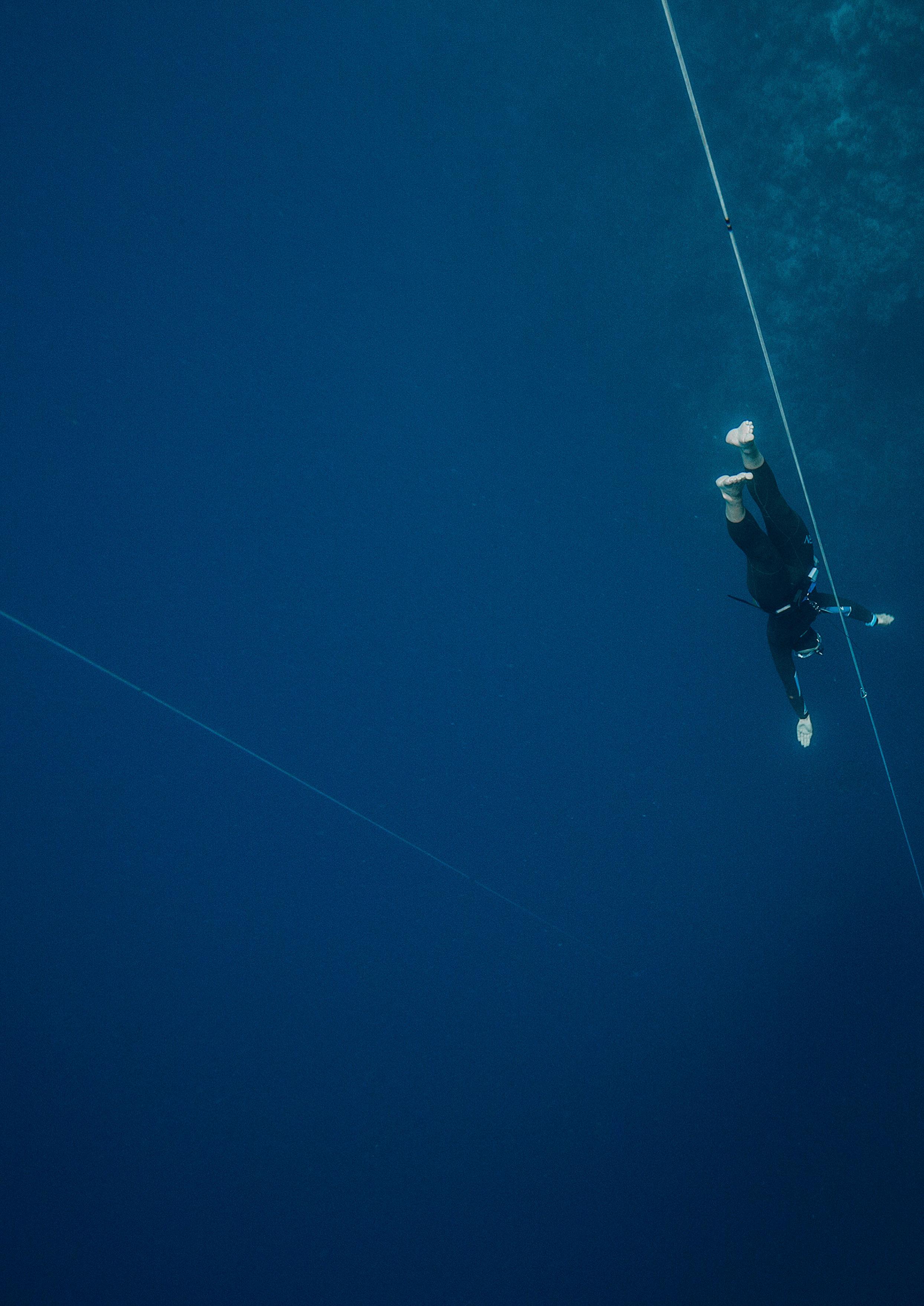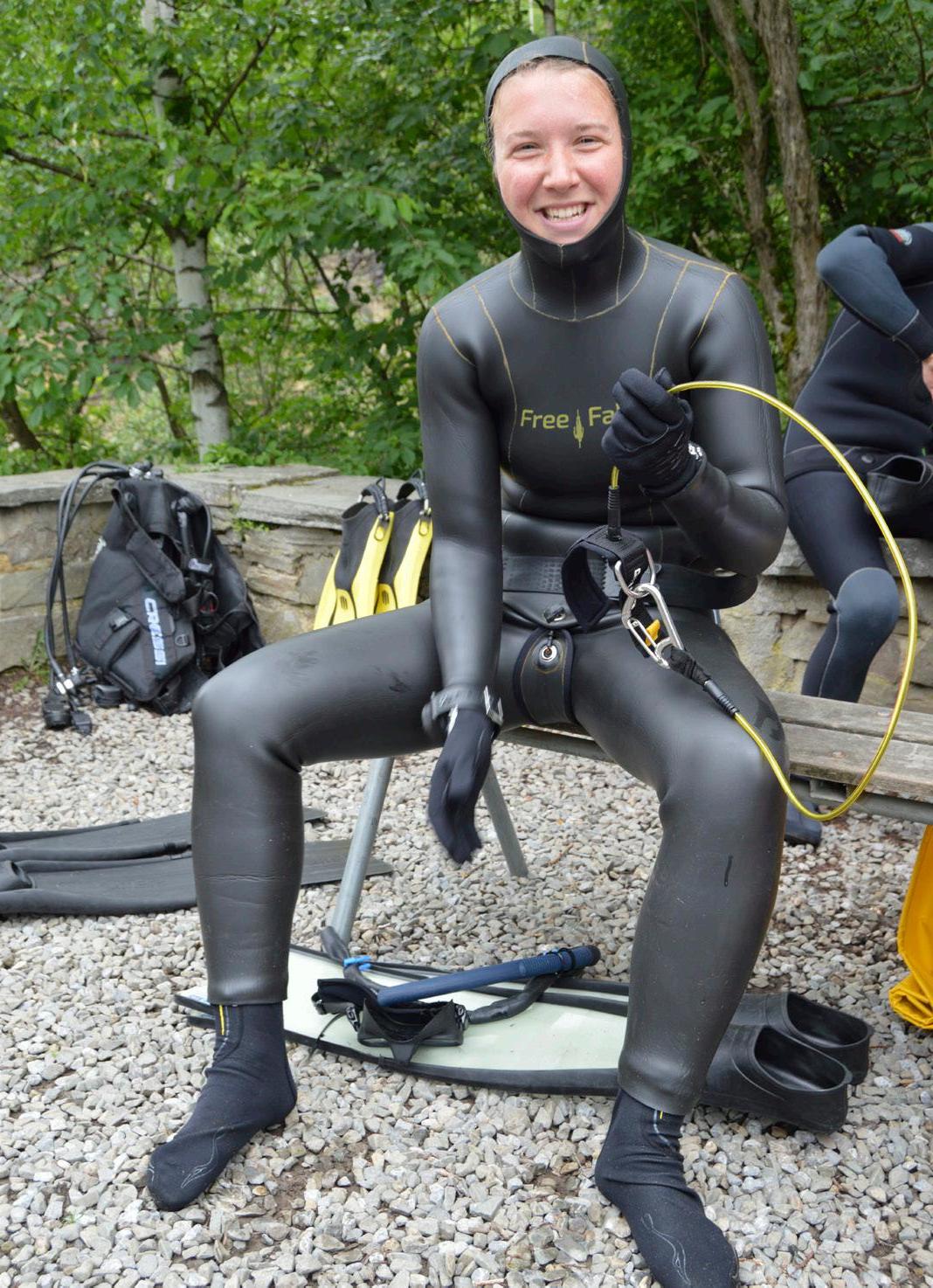
7 minute read
My Buddy The Finless Diver
FEATURE PATRICK VAN HOESERLANDE
On the morning of my next dive appointment, I feel a bit like the weather today: grey. Not that I have suddenly aged, but I don’t like where I’m headed. Firstly, it has been a while since I participated in a free dive pool training. Secondly, I am very bad at swimming breaststroke. Why am I so worried about it? Well, today I’m meeting with Linde Muyshondt, the Belgian record holder in the no fins discipline, referred to as ‘constant weight no fins’ or CNF.
Advertisement

Google her name combined with the word AIDA, and you will understand why I feel uncomfortable. In line with the concept of this series, I will indeed dive with her, in her preferred style, which means diving vertically in breaststroke. A disaster scenario takes place before my mind’s eye. When I enter the cafeteria of the dive tank Transfo in Zwevegem (Belgium), I receive news that does not improve my mood: she and I are to be a team. Only us two! That means a lot of diving. Apnea diving, assuring safety, interviewing and taking photos – that involves multitasking.
How did I get to know Linde? By attending a freediving course, I sometimes find myself in environments outside those frequented by scuba divers. Contrary to what I thought, our federation has a patchwork of various branches of the underwater sport. From time to time, you meet divers specialised in different underwater activities from your own. During a meeting with apnea divers, Linde was congratulated for her record and this immediately caused an alarm to go off in my mind. Not that I was aware of her Belgian record – I have no excuse for that lack of knowledge – but by breaking that record, she became a prime candidate for this series. Who else would be better suited to lead readers into the world of CNF? In hindsight, I recalled that I had once seen her during a practice session in the deep pool Nemo 33. After that training, I walked up to her to ask her to consider being my buddy for this series.
Back to Zwevegem. The moment the dive organiser has told me I am to partner with Linde, I notice she is already diving in the tank. I look through the glass and see her making a turn. To my astonishment, I notice that she slightly descends with every forward arm movement to rise directly a few metres thereafter. CNF is not an evenly smooth movement. My courage fails me, but it is too late to back out. Meekly, I follow the rest of the divers to the changing rooms.
In a few words at the buoy, I explain the idea of our dive. I hear myself saying that the objective is that I dive in her preferred style. Now there is definitely no way out. She smiles and suggests that we warm up by loosely diving several times into free immersion. I like this style, whereby you dive by pulling on the descending line, because of the great control over the descent and ascent speed. This starts out well. My confidence grows.

During the recovery breaks, I ask her why she likes diving without fins so much. She gives me several reasons. It is the freediving discipline that demands the most muscular effort. After all, you must swim down and up without tools such as fins ora shot line.Besides,you don’t need much to practice it. A nose clip in your dive box is enough. You don’t even need a descent line with a buoy, and without any equipment, the direct contact with the water is intensified. I wonder if I will have this same experience.
From diving with the help of a cable, we switch to vertical swimming. Before I descend to the bottom in this way for the first time, I ask my buddy for some tips. She does not provide any, because she first wants to see how I would do it. For obtaining good lift –the final stage of freediving in which you as a diver feel you are lifted by the slightly positive buoyancy – I prefer being a little too light. This results in a difficult star t because I must think about too many things at the same time. After three strokes I succeed and head for the bottom in breaststroke. I flip at the turning point and swim back up until Archimedes’ hand lifts me up. I break the surface and perform the safety protocol to finish the dive.
It went better than expected, but I’m not sure how to feel about the dive as I had too much to think about. I put my fins back on because it’s Linde’s turn and I must assure her safety. I get some tips on my performance while we change roles. Equalise your ears preventively before diving and repeat this in the middle of every stroke. She tells me to do this by stretching one arm forward after a full breaststroke cycle while pinching the nose with the other hand. In the meantime, thrust with your legs. My mental ‘to do’ list gets longer.
After Linde demonstrates it perfectly, it’s back to me. My second attempt is much more successful and the alternation of arm movement and equalisation goes better than expected. We dive a few more times. Thanks to the improved equalisation technique, I can reach greater depths. But we are not yet using the nose pin. That is the next step.
Masks off and clip on. Now the strokes may follow each other without interruptions. After all, I do not need a free hand for equalisation anymore. It feels unnatural. The view is also reduced to a blurred “pool view” without the mask. Automatically you become more aware of your body and less of your surroundings. After a few immersions, I have the feeling that I’m getting better. I’m starting to enjoy it. Linde has already observed this change in my state of mind and claims that this will become my favourite style of freediving, something I do not admit.

We go into our last 30 minutes when she proposes I get rid of my socks. I wear them in order to more easily get in and out of my pool fins. I do not object to her suggestion. This improves the contact with the cold water. Then she proposes I also remove my hood. This increases further connection with the water. Now she unzips the surface buoy and takes the lanyard off. Because the water in the Transfo is clear and not deep, the use of a personal connection with the descending line, (the lanyard) is not required and so we decide to not use them. She says that diving without a hood increases the risk of disorientation. An extra aid to find your way up is therefore recommended. The experience promises to be more intense. And that is indeed the case!
After a few dives, we hear the stop signal. Because it is her turn, we agree that she will perform a last CNF dive and that I will meet her directly as she starts the ascent. When she emerges, she is all smiles. I have rarely met someone who enjoys a good dive as much as this, let alone an apnea dive. She fully enjoys this discipline and it fits her perfectly. If she combines this pleasure for the discipline with the tenacity to improve through training, her current record will quickly be broken again. We will certainly see her name appear more than once. And this time, I’ll pay attention.
After a BBQ, I drive back home. The sun starts fluttering through the clouds. The dive was much nicer than I had expected. I am smiling behind the wheel. Thank you Linde, for letting me be a part of your team and introducing me to the no fins diving discipline. I check off another dive aspect from my list and read up on what my next buddy will teach me.
Aha, that one I’m looking forward to. That will be nice.
Do you know someone who could teach me something new with regards to a niche in diving? Send me an email at patrick. vanhoeserlande@nelos.be.

Diver: Linde Muyshondt
First Year: 2016
Total Dives: I don’t know the total number of dives, because these are not logged (during a 2 hour free diving session, you can easily dive 15 times).
Club: Scylla Diving Aarschot
Certification: CMAS 4* Apnea Diver
Other Certs: SSI Instructor
Special Equipment: No Fins
Favourite Dive Site: Put van Ekeren
Favourite Dive Site Abroad: Too many to list.
Preferred Type of Dive: Finless free diving.










